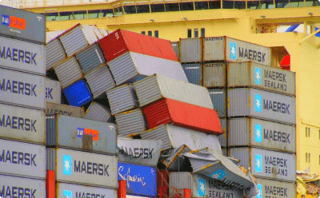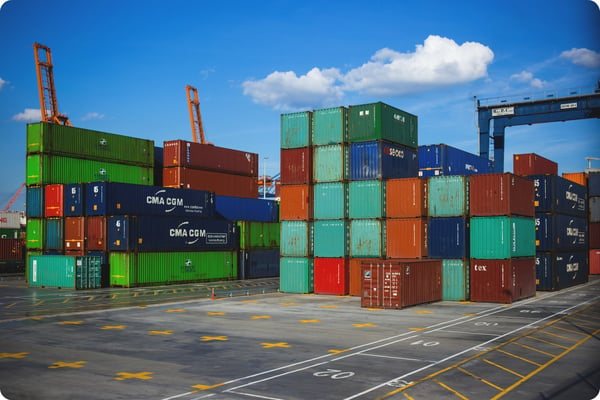If you import parts, products, or materials from overseas, it’s likely your cargo will end up in a ship hold at some point in the supply chain. Cargo ships are commonly used for transporting goods from Asia and other international production sites to the United States. When your cargo is loaded onto a ship, it’s usually stored in the hold, the large storage space under the deck.
You would assume that a ship hold would be the safest possible location for your cargo. After all, most ship holds are ventilated and durable.
As soon as the cargo makes it onto the ship, it should be protected against most types of damage, right?
Not necessarily.
Just because a ship hold is ventilated and well-built doesn’t necessarily mean it’s risk-free. There are still many threats that can arise during overseas transit.
Perhaps one of the biggest potential risks is
the shifting of cargo in the hold.
Compounding the problem, you may not become aware of the issues until the ship arrives, which could be weeks after the cargo was produced and packaged from the overseas location. You may have to wait weeks more to get replacement materials, and that could threaten your timeline and your margins.
Fortunately, you can take steps to minimize ship hold threats and protect the quality of your parts and products. Below are some of the most common risks that arise in ship holds along with steps you can take to enhance protection.
Ship Hold Risks
The specific risks that your cargo may face during transit depends on a number of factors, including the vulnerabilities of your products, the quality of your packaging, and the quality assurance processes of the shipping company. However, there are a few common risks that may be present during any overseas transport, including:
Shifting in the hold.
Perhaps one of the biggest potential risks is the shifting of cargo in the hold. Most cargo ships travel over open waters. Depending on conditions, the ship could get hit with sizable waves, which could cause cargo in the hold to shift.
Most ships are built to withstand waves and rough conditions. However, some could be vulnerable to rocky waters. If your parts or materials or vulnerable to movement and shifting, they could be damaged during the transit process.
Loading drops.
How does your shipping partner load cargo into the ship hold? Some companies use a crane to carefully load pallets, crates, and other cargo into a precise location in the hold.  Others use a conveyor belt or some other kind of device to drop the cargo in.
Others use a conveyor belt or some other kind of device to drop the cargo in.
It's not uncommon for cargo to be damaged during the loading process. The shipping company may have a large volume of containers to load into the hold in a short period of time. They may not take the care that you would like with your cargo. Unfortunately, that could lead to damage that you may not discover until the cargo arrives at your facility.
Dust.
By their very nature, ship holds are often dusty. While most ship holds have some form of ventilation, it may not be enough to protect the air quality inside the hold. If your products and materials are vulnerable to dust or other air contaminants, the ship pulled could be an especially risky storage location.
Moisture.
Perhaps one of the greatest threats in a ship old is moisture. Again, your cargo ship is likely traveling over open ocean waters. Obviously, ships are built to not take on water. However, it is possible for moisture to seep into the hold.
For example, moisture and water could enter the hold through ventilation ducts. Changes in temperature could cause the inside of the hold to sweat, filling the air with moisture. If it’s a long trip, that moisture could continue to accumulate within the hold for the duration, posing a sizable risk to your materials and products.
Ship Hold Protection Strategies
The good news is there are steps you can take to minimize these risks and protect your cargoes quality while it is in transit. Below are a few strategies to consider if you ship cargo from overseas locations.
Use the right cargo company.
 One effective strategy to protect the quality of your products is to choose a cargo company that makes quality assurance a top priority. Look for a company that has procedures and processes in place to protect quality through every stage of the transit process, from loading to shipping to unloading.
One effective strategy to protect the quality of your products is to choose a cargo company that makes quality assurance a top priority. Look for a company that has procedures and processes in place to protect quality through every stage of the transit process, from loading to shipping to unloading.
It may be hard to do your due diligence on shipping companies if you don't have eyes and ears on the ground overseas. That's why it may be helpful to work with a third-party supply chain company that has an overseas presence. The company can help you identify potential risks and search for shipping companies who will help you minimize those risks.
Package strategically.
You may be using packaging materials that don't fully protect your products from the most dangerous quality risks. For example, wooden crate packaging may not be sufficient if moisture could be an issue in the ship old. A container that relies on substantial dunnage, such as foam peanuts or shredded paper, may not protect against shifting and movement.
Take a strategic approach to your packaging and use materials and designs that target your most dangerous risks. An industrial packaging partner that creates custom solutions can help you with this process.
GPS technology.
Sometimes the best protection is having full transparency. You can use GPS technology to track your cargo during transit and monitor the conditions of the hold. Most people know GPS technology as a tool for monitoring location. However, it can also be used to monitor and measure things like vibration, temperature, humidity, and much more.
You can place a GPS in your container to track specific risks. If you notice the temperature or humidity rising to dangerous levels, you may be able to contact the shipping company and ask them to check the hold’s condition. At the very least, you can use that information to guide your choice of shipping partner for future cargo.
Ship holds are a fact of life if you import parts and materials from overseas suppliers. While most ship holds are built to protect quality, your cargo could still face risks. With careful planning and innovative thinking, you can minimize these threats and protect your quality and bottom line. ![]()






Let Us Know What You Thought about this Post.
Put your Comment Below.